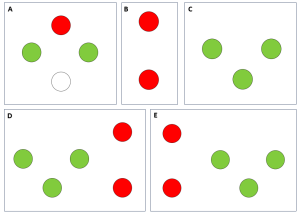Worth 4 Dot
All content on Eyewiki is protected by copyright law and the Terms of Service. This content may not be reproduced, copied, or put into any artificial intelligence program, including large language and generative AI models, without permission from the Academy.
Introduction
The Worth Four Light Test (Worth's Four Dot test, W4LT) is a clinical test assessing binocular vision, including diplopia, suppression, and anomalous retinal correspondence (ARC). This simple test can be performed even on verbal children.
Procedure
With habitural refractive correction in place, if indicated, place Worth 4-dot glasses on the patient. By convention, the red lens goes over the right eye. The patient is shown a flashlight or wall mounted target with 4 illuminated dots in a diamond configuration: 1 red on top, 2 green on the sides, and 1 white on the bottom. The test is performed at both 33 cm and 6 m. The lights can be left on to promote motor fusion or can be turned off if greater dissociation is preferred.
The patient is then asked to describe what they see, including the number, location, and color of lights. Patients should be asked if all of the lights are constant or if some come and go.
Interpretation
Wearing the red-green (red on the right) glasses or polarized glasses, the lens on the right blocks green light and the lens on the left blocks red light. The right eye sees only the red and white lights at 12 and 6 o’clock; the left eye sees only the green and white lights at 3, 6, and 9 o’clock. The white light will appear red through the red lens and green through the green lens. When the images from the two eyes are superimposed, the white light may appear as only red or only green, depending on ocular dominance, or may switch between red and green.
Reported patient percpetion:
Four dots: This indicates a normal result in patients with normal alignment during testing, In patients with manifest strabismus during testing, this indicates anomalous retinal correspondence (ARC).
Two red dots: Left eye suppression
Three green dots: Right eye suppression
Five dots with red on the right and green on the left: Uncrossed diplopia. This is expected in esotropia and indicates ARC in exotropic patients.
Five dots with green on the right and red on the left: Crossed diplopia. This is expected in exotropia and indicates ARC in esotropic patients.
Suppression of one eye at distance with normal response at near: Consistent with a monofixation syndrome. A 1-4° degree scotoma is typical of monofixation syndrome. At ≥3 m, the flashlight projects ≤1° onto the central retina and will not be seen in the eye with the scotoma. At near, the lights project outside of the scotoma, allowing for the lights to be viewed with both eyes.
References
- Worth C. Squint: Its causes, pathology and treatment. Philadelphia: Blakiston, 1908
- Noorden GK von. Binocular vision and ocular motility: theory and managment of strabismus, 5th Ed. St Louis: Mosby, 1996.
- Duane’s Clinical Ophthalmology. New York: Lippincott Williams & Wilkins, 2005.
- Jeon, HS., Choi, HY. (2019). Binocular Function Test. In: Lee, JS. (eds) Primary Eye Examination. Springer, Singapore. https://doi.org/10.1007/978-981-10-6940-6_6


